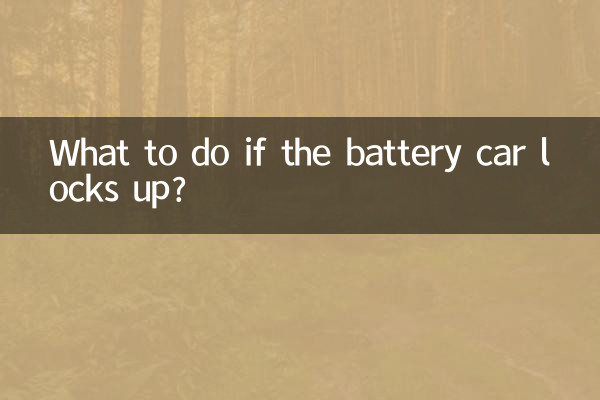What should I do if the battery car locks up? Analysis and response guide to hot topics on the Internet in the past 10 days
Recently, the safety issue of battery vehicles has become the focus of heated discussions on the Internet, especially the phenomenon of "battery vehicle lock-up" which has triggered widespread discussion. This article combines the hotspot data of the entire network in the past 10 days to provide you with structured analysis and practical solutions.
1. Statistics of hot topics related to battery vehicles across the entire network (last 10 days)

| Ranking | Topic keywords | Number of discussions (10,000) | Main platform |
|---|---|---|---|
| 1 | Battery car locked up | 28.5 | Douyin/Zhihu |
| 2 | Brake failure | 19.2 | Weibo/Bilibili |
| 3 | Battery spontaneous combustion | 15.7 | Today's headlines |
| 4 | Implementation of new national standards | 12.3 | WeChat/Tieba |
| 5 | Modification risk | 9.8 | little red book |
2. In-depth analysis of the locking phenomenon of battery vehicles
According to feedback from netizens and expert analysis, battery vehicle lock-ups mainly occur in the following three situations:
| type | Proportion | Typical performance |
|---|---|---|
| Brake system locked up | 62% | The wheels are completely locked and cannot be driven. |
| Controller failure | 25% | The motor continuously outputs power |
| Mechanical stuck | 13% | Foreign objects stuck in transmission parts |
3. Five steps for emergency treatment
When encountering a locked battery vehicle, please follow the steps below:
1.Power off immediately: Turn off the main power switch or remove the key to prevent continuous power supply to the circuit.
2.try to unlock: Repeatedly operate the brake handle 3-5 times, and some electronic brake systems can automatically reset.
3.Check brake lines: Observe whether the brake line is broken or stuck, and manually loosen the brake line fixing nut if necessary.
4.Car moving skills: If the rear wheel locks, you can try to lift the rear wheel to push; if the front wheel locks, you need to control the direction carefully.
5.Professional maintenance: Even if it returns to normal temporarily, you should go to the maintenance point for a comprehensive inspection as soon as possible.
4. Comparison table of preventive measures
| prevention project | Operational points | Recommendation cycle |
|---|---|---|
| Brake system maintenance | Clean brake drums and replace brake pads | every 3000 kilometers |
| Line check | Check the aging condition of the line | 1 time per month |
| tire maintenance | Maintain standard tire pressure | Weekly inspection |
| Controller waterproof | Check tightness | before rainy season |
5. Precautions for consumer rights protection
According to the latest data from the Consumers Association, mechanical failures account for 37% of complaints about battery vehicles. When encountering quality problems you should:
1. Keep the car purchase invoice and three-guarantee certificate
2. Take a video of the malfunction as evidence
3. Complain through the 12315 platform
4. Request the merchant to issue a test report
6. Technology Frontier Trends
New technologies recently introduced by the industry can effectively prevent locking:
| Technical name | principle | Application models |
|---|---|---|
| E-ABS system | Electronically controlled braking force | High-end electric motorcycle |
| Dual circuit brake | Mechanical/electronic double insurance | New national standard models |
| Intelligent diagnosis | Early warning of failures | Internet of things models |
It is recommended that consumers give priority to models equipped with these safety technologies when purchasing. Although the price may be 15%-20% higher, the safety performance is significantly improved.
From the above analysis, it can be seen that the problem of battery vehicle lock-up needs to be paid attention to in the entire chain from prevention, emergency treatment to rights protection. Regular maintenance, standardized operation and selection of regular products are the keys to ensuring driving safety. It is recommended that users go to professional institutions for systematic safety inspections every six months to fundamentally eliminate safety hazards.

check the details

check the details